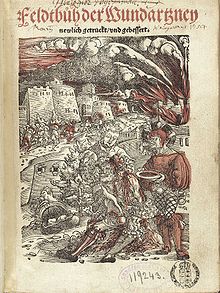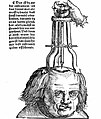Hans von Gersdorff (doctor)
Hans von Gersdorff , called Schielhans , also Johannes von Gersdorff (* around 1455 , probably in Strasbourg ; † 1529 in Strasbourg), was a German surgeon .
Life
Hans' father was probably also a surgeon and came from Görsdorf in Lower Saxony . During the Burgundian Wars , Hans von Gersdorff was trained by the then well-known Tyrolean surgeon and gynecologist Klaus von Matrei (* around 1440; † around 1490) and became famous as Schylhans . He was a citizen of Strasbourg and among other things worked as a qualified surgeon at the Antoniterhof in Strasbourg.

Act
1517 the printer Johann Schott published (1477-1548) in Strasbourg , a book authored by Hans von Gersdorff, illustrated with woodcuts surgical manual under the promotionally effective title "Field Book of Wundarzney".
The field book contains, among other references to the work of the medieval doctor Guy de Chauliac , a German translation of his anatomy from the Chirurgia Magna . The section on bloodletting (Chapters 13-16) is a German translation of the corresponding Latin statements in the Fasciculus Medicinae printed in Venice in 1491 , which in turn are based on a Latin text that was first published between 1450 and 1470 in a manuscript written in southern Germany ( Cpg 644 ) is tangible.
Gersdorff's book was widely used and for many years was the most important basis of surgery in Europe. It is well known, especially because of its explanations on the amputation of extremities . Gersdorff performed at least 200 such amputations himself.
The field book contains four anatomical woodcuts , including a depiction of a bloodletting showing the internal organs . The other images show a man wounded with a variety of weapons that were common at the time, a skeleton and another representation of the internal organs. More woodcuts of the book show the diagnostics ( leprosy show , uroscopy ) in leprosy , surgical procedures such as amputations and reducing bone.
The picture table of the intestines with the representation of the opened body names the illustrator Hans Waechtlin in the rhymed text . Two more of the anatomical woodcuts in the book are attributed to the master, namely the opened body of the bloodletting man and - with uncertain attribution - the skeleton.
"Paper" that appeal to the Veltbuch joined the Hans von Gersdorff, were the Veltbock the so-called "Kinder Bock", one dating from around 1600 Low German Pharmacopoeia , and in 1551 published Stat and Feldtbuch evaluator Wundtarznei of Walther Hermann Ryff .
- Plates from the "Wundarzney Field Book"
Fonts
- Feldtbůch der Wundtartzney . Johann Schott, Strasbourg 1517 Digitized BSB Munich
- Feldtbůch der Wundtartzney, newly printed, and improved. Johann Schott, Strasbourg 1528 Digitized BSB Munich
- Feldtbůch der Wundtartzney. [Augsburg] [approx. 1532] Digitized BSB Munich
- Feldtbůch der Wundtartzney, newly printed, and improved. [Strasbourg] 1535 Digitized BSB Munich
- Feldtbůch der Wundartzney, sampt many instruments of the surgeon. Vß the Albucasi contrafayt. … Johann Schott, Strasbourg 1540 digitized BSB Munich
literature
- Biographical
- Melanie Panse: Hans von Gersdorff's "Field Book of Wound Medicine". Dr. Ludwig Reichert Verlag, Wiesbaden 2012, ISBN 978-3-89500-907-5 .
- Fabian Ulrich Nohe-Griesler: What we know about “Schielhans”. Source studies on Hans von Gersdorff. Medical dissertation. University of Cologne 2019.
- August Hirsch : Gersdorff, Hans . In: Allgemeine Deutsche Biographie (ADB). Volume 9, Duncker & Humblot, Leipzig 1879, p. 57.
- Ernest Wickersheimer : Gersdorff, Hans von. In: New German Biography (NDB). Volume 6, Duncker & Humblot, Berlin 1964, ISBN 3-428-00187-7 , p. 322 f. ( Digitized version ).
- Johann Ludwig Choulant : History and bibliography of anatomic illustration . Trans. And annotated by Mortimer Frank. (New York: Hafner, 1962). Pp. 162-166.
- Jan Frederiksen: Johannes von Gersdorff. In: Author's Lexicon . 2nd Edition. Volume 4, Col. 626-630.
- Jeremy Norman (Ed.): Morton's Medical Bibliography. 5th edition (Aldershot, Hants., England: Scolar Press; Brookfield, Vt., USA: Gower Pub. Co., 1991). No. 5560.
- Reprints
- Field book of wound medicine. Reprint of the Strasbourg edition from 1517 with a foreword by Johannes Steudel . Scientific Book Society, Darmstadt 1967; further editions: Lindau im Bodensee 1978; Osnabrück 1981.
supporting documents
- ^ Gundolf Keil: Klaus von Matrei. In: Werner E. Gerabek , Bernhard D. Haage, Gundolf Keil , Wolfgang Wegner (eds.): Enzyklopädie Medizingeschichte. De Gruyter, Berlin / New York 2005, ISBN 3-11-015714-4 , p. 702.
- ^ Gundolf Keil: Johannes von Gersdorff (Schielhans). In: Encyclopedia of Medical History. 2005, p. 702.
- ^ Gundolf Keil: The German Isaak Judäus reception from the 13th to the 15th century. Shaker, Aachen 2015 (= European Science Relations, Supplement 2), p. 64 f.
- ↑ See also Karl-Wilhelm Grabert: The nomina anatomica with the German surgeons Hieronymus Brunschwig and Hans von Gersdorff, their relationship to Guy de Chauliac and their relationship to the Jenenser nomina anatomica of 1935. A contribution to the history of the anatomical nomenclature, with a sketch about the life, work and position of the three authors in German anatomy and surgery in the Middle Ages. Medical dissertation Leipzig 1943.
- ^ Cpg 644. Medical tracts and prescriptions . Southern Germany 1450 - 1470, sheets 63v-76r bloodletting rules and zodiac diagnostics. Latin (digitized version)
- ↑ Fasciculus Medicinae . Gregoriis, Venice July 26th 1491 (digitized version)
- ↑ Hans von Gersdorff. Field book of wound medicine . Schott, Strasbourg 1517, sheet 14v-18r (digitized version )
- ↑ Friedrich Lenhardt: “When ain man willingly let go”. Instructions for the therapy of complications in bloodletting. In: Gundolf Keil (ed.): "Gelêrter der arzeniê, ouch apotêker". Contributions to the history of science. Festschrift for the 70th birthday of Willem F. Daems. Horst Wellm Verlag, Pattensen / Hannover 1982 (= Würzburg medical-historical research. Volume 24), ISBN 3-921456-35-5 , pp. 269-300, here: pp. 280-281.
- ^ Johann David Passavant , Adam Bartsch : Le Peintre-Graveur , Vol. 3, Leipzig 1862, p. 327 and p. 332ff. (Digitized version)
- ^ Gundolf Keil: 'Kinderbock' (Copenhagen, Kgl. Bibl., Ms. GKS. 4 ° 1663, 87 r –146 v ). In: Werner E. Gerabek, Bernhard D. Haage, Gundolf Keil, Wolfgang Wegner (eds.): Enzyklopädie Medizingeschichte. De Gruyter, Berlin / New York 2005, ISBN 3-11-015714-4 , p. 740.
Web links
- Literature by and about Hans von Gersdorff in the catalog of the German National Library
- Works by and about Hans von Gersdorff in the German Digital Library
- Gerdorff, Hans von: Feldbuch der Wundtartzney - high-resolution digitized version in the culture portal bavarikon
| personal data | |
|---|---|
| SURNAME | Gersdorff, Hans von |
| ALTERNATIVE NAMES | Schyl-Hans |
| BRIEF DESCRIPTION | German surgeon |
| DATE OF BIRTH | around 1455 |
| DATE OF DEATH | 1529 |
| Place of death | Strasbourg |






